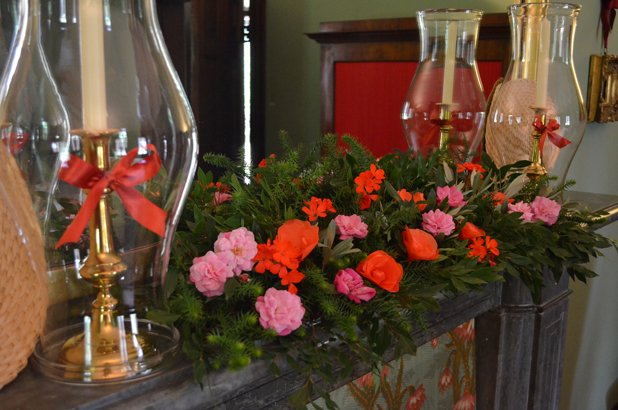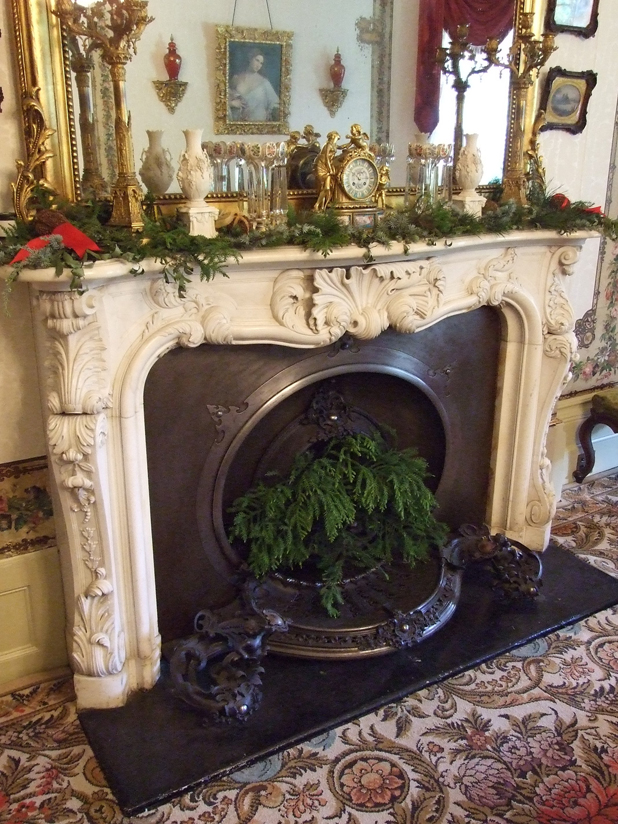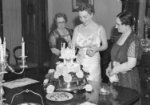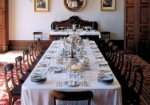Think back to a time before tinsel, fairy lights and singing Santas. In early 19th century Britain, the favourite Christmas decorations were the age-old ‘holly and the ivy’, along with evergreens such as mistletoe and pine. In Australia however, where the vegetation was evergreen, the symbolic value of a few precious green leaves emerging from a snow-covered landscape was replaced with scenes of abundance.
The colonists embraced this profusion of greenery and flowers, as they reinvented European Christmas traditions: rooms could now be filled with vases, chimneypieces shrouded in foliage and dotted with fresh blooms, and doorways and verandah posts turned into leafy bowers. This arrangement in the drawing room at Elizabeth Farm evokes that botanical exuberance, with the chimneypiece covered in hoop pine, Chinese elm, sprigs of olive, China roses and scarlet pelargoniums all picked from the garden surrounding the house, with handmade paper flowers to complete the display.
The use of native plants
While European holly remained a sentimental favourite – even if only a tiny sprig could be obtained from a friendly gardener for the pudding – native plants were quickly and enthusiastically adopted for Christmas decorations.
Perhaps the most popular was Christmas bush (Ceratopetalum gummiferum) – named for its timely flowering. Its bright red flowers reflected the traditional green and red colour scheme, while its pointed leaves brought to mind the sharp points of the holly. The nodding green and red Blandfordia flower, quickly dubbed ‘Christmas bells’, was also eagerly sought (these are now being commercially grown, and are seen in greater numbers in florists each year – which is excellent as they are a protected plant in the wild). Branches of native araucarias such as the hoop pine (Araucaria cunninghammii), were also popular because of their resemblance to European pines and conifers. These could be tied to posts, doorframes and banisters, laid across chimneypieces or in suspended light fittings, or tied into swags. Native mistletoes were gathered and hung, watching over many a Christmas kiss. Long fronds of the native tree ferns (Cyathea and Dicksonia sp.) were especially prominent, and were placed behind mirrors or picture frames like triumphal palm fronds. In the 3rd quarter of the 19th century, when the ‘Christmas tree’ itself became popular, a range of native trees including the Norfolk pine (A. heterophylla) became the Antipodean equivalent of the fir and the spruce – though wattles and many other trees were pressed into festive service by the creatively minded!
Below, you see the drawing room at Vaucluse House with the chimneypiece decorated in hoop pine picked from trees planted in the 19th century. The sharp -eyed will also spot pomanders (made from oranges studded with cloves) and pine cones from the stately Chir pines (Pinus roxburghii, or Himalayan pine) that grow in the paddock west of the house. The grate is filled with a bough of hoop pine, which after Christmas is replaced with a pot of graceful maidenhair fern.
In the hot Australian summer great branches of greenery, flowering Christmas bush or attractive potted plants from the ‘bush-house’, were brought indoors and installed in empty fireplaces. Carts full of Christmas bush, Christmas bells and ferns, and even boatloads from less accessible areas, were sold in the markets or door-to-door. Louisa Anne Meredith (1812 – 1895) wrote of the prodigious harvest in 1844:
For some days before Christmas, in our drives near town, we used to meet numbers of persons carrying bundles of a beautiful native shrub, to decorate the houses, in the same manner that we use holly and evergreens at home. Men women and children, white, brown and black were in the trade: and sometimes a horse approached so covered with the bowery load he bore, that only his legs were visible, and led by a man nearly as much hidden; carts heaped up with the green and blossomed boughs came noddingly along, with children running beside them, decked out with sprays and garlands, laughing and shouting in proper Christmas jollity.
Notes and Sketches of New South Wales during a residence in the colony from 1839 to 1844. London, John Murray, 1844
By the 1850s the annual harvest was having a heavy toll, as tree ferns, cycads, Christmas bush and bells were becoming scarce in the Sydney region harvesters often traveled far to secure a source. In 1879 the Illustrated Sydney News commented:
The beautiful “Christmas Bush”… and scores of other ornamental shrubs give their contribution to the beauty of Australia’s Christmas. Indeed, it may be said that the whole bush is ransacked for the various forms of vegetable life suitable for Christmas decoration ; and the owners of land have as much difficulty in guarding their surroundings here, as have the owners of English estates to protect themselves against the annual raids on their holly trees (Dec. 24, 1879).
Ironically, rather than guarantee their own supply, many urban gardeners decided not to plant these favourites because of the risk of seasonal pilfering (I remember as a child our neighbours, who had a magnificent Christmas bush in their front yard, becoming especially vigilant each December). Some writers mention the yellow flowering wattles as being a popular alternative choice, and in this they reflect an emerging colonial pride and spirit.
This year Elizabeth Farm, Elizabeth Bay House and Vaucluse House are traditionally decorated for Christmas. Vaucluse House also has a Christmas tree – a feature of later Victorian houses, and a treat for the Wentworth children.



